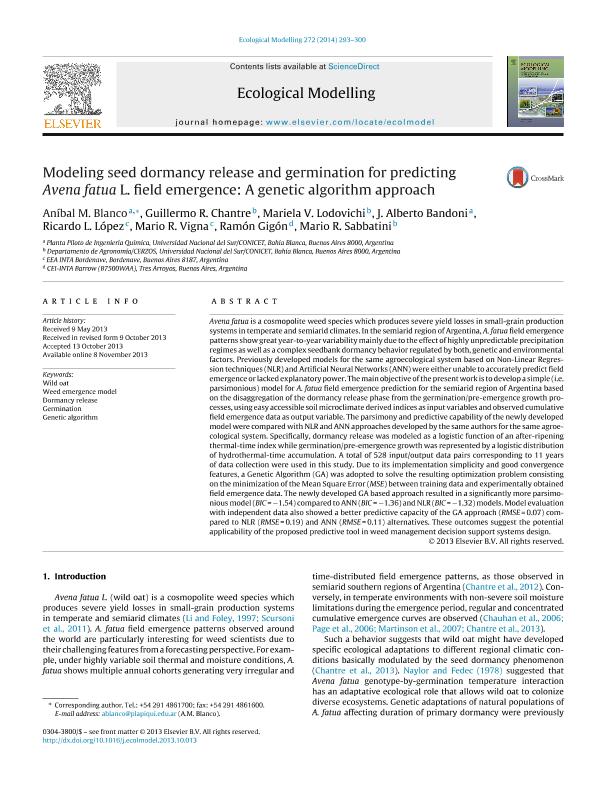Artículo
Modeling seed dormancy release and germination for predicting Avena fatua L. field emergence: A genetic algorithm approach
Blanco, Anibal Manuel ; Chantre Balacca, Guillermo Ruben
; Chantre Balacca, Guillermo Ruben ; Lodovichi, Mariela Victoria
; Lodovichi, Mariela Victoria ; Bandoni, Jose Alberto
; Bandoni, Jose Alberto ; Lopez, Ricardo L.; Vigna, Mario R.; Gigón, Ramón ; Sabbatini, Mario Ricardo
; Lopez, Ricardo L.; Vigna, Mario R.; Gigón, Ramón ; Sabbatini, Mario Ricardo
 ; Chantre Balacca, Guillermo Ruben
; Chantre Balacca, Guillermo Ruben ; Lodovichi, Mariela Victoria
; Lodovichi, Mariela Victoria ; Bandoni, Jose Alberto
; Bandoni, Jose Alberto ; Lopez, Ricardo L.; Vigna, Mario R.; Gigón, Ramón ; Sabbatini, Mario Ricardo
; Lopez, Ricardo L.; Vigna, Mario R.; Gigón, Ramón ; Sabbatini, Mario Ricardo
Fecha de publicación:
01/2014
Editorial:
Elsevier Science
Revista:
Ecological Modelling
ISSN:
0304-3800
Idioma:
Inglés
Tipo de recurso:
Artículo publicado
Clasificación temática:
Resumen
Avena fatua is a cosmopolite weed species which produces severe yield losses in small-grain production systems in temperate and semiarid climates. In the semiarid region of Argentina, A. fatua field emergence patterns show great year-to-year variability mainly due to the effect of highly unpredictable precipitation regimes as well as a complex seedbank dormancy behavior regulated by both, genetic and environmental factors. Previously developed models for the same agroecological system based on Non-Linear Regression techniques (NLR) and Artificial Neural Networks (ANN) were either unable to accurately predict field emergence or lacked explanatory power. The main objective ofthe present work is to develop a simple (i.e. parsimonious) model for A. fatua field emergence prediction for the semiarid region of Argentina based on the disaggregation of the dormancy release phase from the germination/pre-emergence growth processes, using easy accessible soil microclimate derived indices as input variables and observed cumulative field emergence data as output variable. The parsimony and predictive capability of the newly developed model were compared with NLR and ANN approaches developed by the same authors for the same agroecological system. Specifically, dormancy release was modeled as a logistic function of an after-ripening thermal-time index while germination/pre-emergence growth was represented by a logistic distribution of hydrothermal-time accumulation. A total of 528 input/output data pairs corresponding to 11 years of data collection were used in this study. Due to its implementation simplicity and good convergence features, a Genetic Algorithm (GA) was adopted to solve the resulting optimization problem consisting on the minimization of the Mean Square Error (MSE) between training data and experimentally obtained field emergence data. The newly developed GA based approach resulted in a significantly more parsimonious model(BIC = −1.54) compared to ANN (BIC = −1.36) and NLR (BIC = −1.32) models. Model evaluation with independent data also showed a better predictive capacity of the GA approach (RMSE = 0.07) compared to NLR (RMSE = 0.19) and ANN (RMSE = 0.11) alternatives. These outcomes suggest the potential applicability of the proposed predictive tool in weed management decision support systems design.
Palabras clave:
Wild Oat
,
Weed Emergence Model
,
Dormancy Release
,
Germination
,
Genetic Algorithm
Archivos asociados
Licencia
Identificadores
Colecciones
Articulos(CERZOS)
Articulos de CENTRO REC.NAT.RENOVABLES DE ZONA SEMIARIDA(I)
Articulos de CENTRO REC.NAT.RENOVABLES DE ZONA SEMIARIDA(I)
Articulos(PLAPIQUI)
Articulos de PLANTA PILOTO DE INGENIERIA QUIMICA (I)
Articulos de PLANTA PILOTO DE INGENIERIA QUIMICA (I)
Citación
Blanco, Anibal Manuel; Chantre Balacca, Guillermo Ruben; Lodovichi, Mariela Victoria; Bandoni, Jose Alberto; Lopez, Ricardo L.; et al.; Modeling seed dormancy release and germination for predicting Avena fatua L. field emergence: A genetic algorithm approach; Elsevier Science; Ecological Modelling; 272; 1-2014; 293-300
Compartir
Altmétricas



